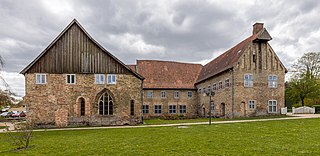
Preetz is a town southeast of Kiel in the district of Plön, in Schleswig-Holstein, Northern Germany. Preetz is also known as "Schusterstadt" named after shoemakers who used to live and work in this town. Preetz has a population of about 16,000 and is the largest city in the district of Plön.

St. Anne's Museum Quarter was previously an Augustinian nunnery, St. Anne's Priory. Since 1915 it has housed St. Anne's Museum, one of Lübeck's museums of art and cultural history containing Germany's largest collection of medieval sculpture and altar-pieces, including the famous altars by Hans Memling, Bernt Notke, Hermen Rode, Jacob van Utrecht and Benedikt Dreyer.

Cismar Abbey was a Benedictine monastery located at Cismar near Grömitz, Schleswig-Holstein, in Germany.

Nütschau Priory is a house of the Benedictine Order located at Travenbrück near Bad Oldesloe, Stormarn, Schleswig-Holstein in Germany.

Preetz-Land is an Amt in the district of Plön, in Schleswig-Holstein, Germany. It is situated around Preetz. The seat of the Amt is Schellhorn.

Oberschönenfeld Abbey is a Cistercian nunnery in Gessertshausen in Bavaria, Germany.

Wahlstorf is a village and municipality in the district of Plön, in Schleswig-Holstein, Germany. It is part of the Amt Preetz-Land.

St. Marx Abbey or St. Mark's Abbey was a Benedictine nunnery in Gueberschwihr (Geberschweier) in Alsace, founded in about 1105. Since 1845 it has been the principal house of the Sisters of St. Joseph of St. Marc, rebuilt in 1852 after a disastrous fire.

Ryd Abbey or Rüde Abbey was a Cistercian monastery in Munkbrarup that formerly occupied the present site of Glücksburg Castle in Glücksburg on the Flensburg Fjord in the Schleswig-Flensburg district of Schleswig-Holstein, Germany.
Guldholm Abbey was a short-lived Cistercian monastery on the Langsee near Böklund, formerly in Denmark, now in Schleswig-Holstein in Germany. It was founded in 1191 and abandoned after less than twenty years; some of the community went on to establish Ryd Abbey.

St. Catherine's Priory, Roskilde was a Danish priory of Dominican friars located in Roskilde. It was established in 1231 and dissolved during the Reformation. In 1699, the private house which replaced the Priory, became the Lutheran Roskilde Adelige Jomfrukloster, a women's collegiate foundation.

Holstein Switzerland is a hilly area with a patchwork of lakes and forest in Schleswig Holstein, Germany, reminiscent of Swiss landscape. Its highest point is the Bungsberg. It is a designated nature park as well as an important tourist destination in Northern Germany situated between the cities of Kiel and Lübeck.

The Kirchsee is a lake in Plön district in the north German state of Schleswig-Holstein, in a region known as "Holstein Switzerland".

The Rosensee is a lake in the region of Holstein Switzerland in the state of Schleswig-Holstein, Germany.
Vissing Priory was a Benedictine nunnery, situated near the monastery of Voer Abbey, but on the northern bank of the Gudenå, close to the present Klostermølle in Vorladegår parish near Silkeborg, Denmark.

The Graukloster, also known as Kloster St. Paul or Kloster St. Paulus, is a former Franciscan monastery located in Schleswig, Germany. It is named after the gray color of the Franciscan uniform. Following the dissolution of the monastery in 1528/29, the convent buildings were transformed into a shelter for the poor (Armenstift), while the church came under the ownership of the town and was converted into a town hall. The present-day classicistic town hall was built on the foundation walls in 1794/95. Some sections of the medieval convent buildings still remain intact and have been utilized by the city administration since the 1980s.














